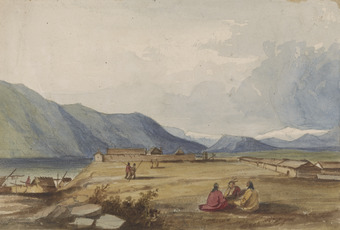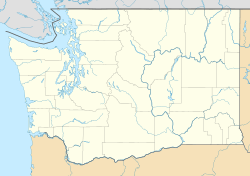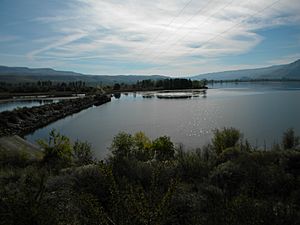Fort Okanogan facts for kids
Quick facts for kids |
|
|
Fort Okanogan
|
|

Fort Okanogan in 1853
|
|
| Location | Okanogan County, Washington, USA |
|---|---|
| Nearest city | Brewster, Washington |
| Built | 1811 |
| NRHP reference No. | 73001883 |
| Added to NRHP | June 4, 1973 |
Fort Okanogan was an important trading post built in 1811. It was located where the Okanogan and Columbia Rivers meet. This fort was one of the first American-owned settlements in what is now Washington state. It was a key spot for the fur trade, where people traded animal furs.
The fort was first built by the John Jacob Astor’s Pacific Fur Company. Later, other big companies like the North West Company and the Hudson's Bay Company took it over. Fort Okanogan was a vital stop on a long trade route called the York Factory Express. This route connected the Pacific Northwest to London, England.
After 1846, when the Oregon Treaty was signed, the fort became less important for furs. It was mostly used for moving goods between other trading posts. The Hudson's Bay Company finally closed the fort in June 1860. In 1967, the area where the fort once stood was flooded by Lake Pateros, a reservoir created by the Wells Dam.
Contents
Early Days with the Pacific Fur Company
The Pacific Fur Company (PFC) planned Fort Okanogan to compete with other fur trading posts. In 1811, PFC workers traveled up the Columbia River. They were joined for part of the journey by a rival group from the North West Company.
As the PFC group moved further up the Columbia, they found that local people already traded with the North West Company. On October 31, PFC leaders met with local Okanagan leaders. The Okanagan people agreed to be friends with the PFC. They also promised to help with beaver trapping, keep the station safe, and make sure the workers had enough food.
After the fort was built, the workers split up. One group went back to Astoria, and another went north along the Okanagan River. A man named Ross stayed at the fort. He felt lonely, even though many friendly local people camped nearby and helped guard the fort at night.
The North West Company Takes Over
When the North West Company (NWC) bought out the Pacific Fur Company's posts, Alexander Ross continued to manage Fort Okanogan. In 1816, Ross Cox became the new officer in charge. He arrived at the fort on April 30.
During that summer, workers used lots of wood to rebuild the fort. They built a tall fence, called a palisade, that was fifteen feet high. There were also two strong towers, called bastions, each with a brass cannon. New homes for the staff were built, along with a large storage building for furs and goods. This building also had a shop for trading with the local people.
The fort's workers ate salmon and deer bought from Indigenous visitors. They also ate plants like sarsaparilla and even rattlesnakes. Some workers wore special waterproof coats made from sea-lion intestines. Attempts to grow crops at the fort were not very successful. Mice and frost often destroyed most of the plants.
One winter, a group of Sanpoils took several company horses from Fort Okanogan. Ross Cox and a small group, including French-Canadians, Hawaiians, and some Okanagans led by Red Fox, went to find the horses. Red Fox guided them through the snow to the Sanpoil village. The village leaders admitted taking the horses, saying they did it because they were starving. Cox got the horses back without any fighting.
The Hudson's Bay Company Era
In 1821, the North West Company joined with the Hudson's Bay Company (HBC). HBC officials visited Fort Okanogan as they traveled to other posts. The four NWC employees at the fort, including one Hawaiian and three French-Canadians, stayed on. The number of staff grew a lot, and by 1826, over 40 Native and White workers lived at the post.
The fort still relied on local Indigenous people for food. They provided over 19,000 salmon each year, along with deer meat. They also supplied many quarts of wapato (a type of plant) and over a thousand quarts of different berries in 1826.
In 1841, HBC Governor Sir George Simpson visited Fort Okanogan. He noted that the fort was mainly used to help transport goods to other posts. He said it was not a big fur trading spot itself because there were not many fur-bearing animals nearby.
In its last twenty years, only one employee, usually with their family, lived at the fort. By 1848, fur trapping groups no longer used the Okanogan Trail to get supplies from Fort Okanogan. They started getting supplies from Fort Hope instead. The company thought about closing the post in 1853 because it was no longer making enough money.
The son of the departing manager, François Duchouquette, was told to work there in 1853. He stayed until 1860, when he was ordered to remove all remaining supplies and property. Duchouquette left on June 18 or 19, leaving the post empty. He later started a new trading post in Keremeos in British Columbia. An observer named Robert Stevenson remembered that many local Indigenous people helped pack up the goods. They prepared loads for 150 horses to move the post to Keremeos.
After the fort was abandoned, American and Chinese gold miners in the area took wood from the old buildings. By 1880, no buildings of Fort Okanogan were left.
Fort Managers
By the time the Hudson's Bay Company took over, Fort Okanogan was not as important for the fur trade. Because of this, no high-ranking company officer was regularly stationed there. Here is a list of some of the people who managed the fort:
| Manager | Position | Years |
|---|---|---|
| Alexander Ross | owner | 1811-1813 |
| William Wallace Matthews | clerk | 1813 |
| Alexander Ross | owner | 1814-1816 |
| Ross Cox | 1816-1817 | |
| William Kittson | clerk | 1822-1823 |
| Louis Pion | interpreter | 1823-1824 |
| James Birnie | apprentice clerk | 1824-1827 |
| François Annance | clerk | 1826 |
| Francis Ermatinger | clerk | 1826-1829 |
| Jean Gingras | post master | 1841 |
| Antoine Felix | in charge | 1842-1843 |
| Joachin LaFluer | interpreter | 1842-1856 |
| François Duchouquette | interpreter | 1856-1860 |
Fort Okanogan State Park and Interpretive Center
Until 2011, there was a place called Fort Okanogan State Park. It was located near the old fort site and the Columbia River. This park was about 45 acres and was used for day visits. It had the Fort Okanogan Interpretive Center (FOIC), which was a museum. The museum showed exhibits about the fort, early settlers, and the fur trapping business.
Because of money problems, the park was no longer owned by the state in 2011. It was given to the Confederated Tribes of the Colville Reservation. The Interpretive Center is now part of the Colville Tribes' History/Archaeology Program. You can visit the center from late May through mid-September.
The park is about five miles (8 km) north of Brewster, Washington. It is closed during the winter months.
See also



